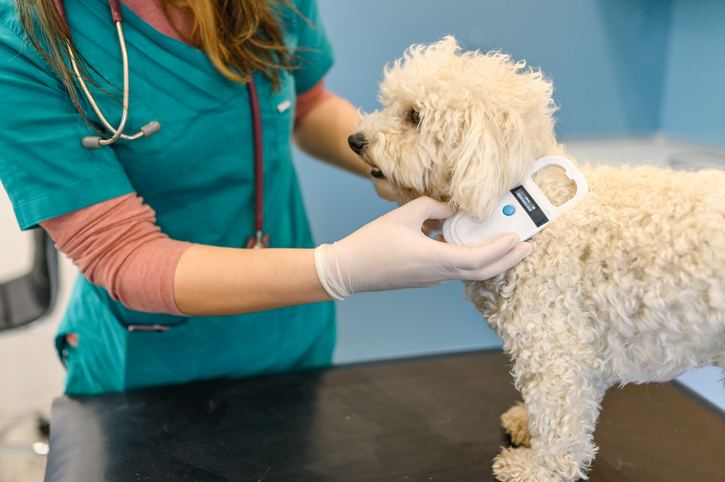Everything You Need to Know About Microchipping Dogs
If you’ve ever wondered if you should get your dog microchipped, but felt you didn’t know enough about it, this article is for you. Each year, countless pets become lost. Some make it back home, but many do not. Some end up being take in by kind people who give them a new home and others end up at shelters. Microchipping has saved many animals from an uncertain future and helped return them to the people who love them. This article will discuss microchipping in detail and why you should microchip your pet.
What Is a Pet Microchip
Pet microchips, also known as a transponder, are pieces of rice-sized technology made of bioglass. A chip has an identification code and uses RFID technology. It is not a GPS device where pet owners can use a cell phone to track a pet.
How Do Pet Microchips Work
Each chip identification, which is an alphanumeric code, is unique and can only be read with a microchip scanner. Typically, shelters, rescues, and veterinarians have scanners. When the chip is scanned it emits a low radio frequency, and the code retrieved. Then the pet’s data can be accessed in the microchip manufacturer’s database. There is no personal data on the chip. The only piece of information it holds is the identification number. Additionally, random people cannot access your pet’s identification information.

How Big Is A Pet Microchip?
A standard microchip is 12mm, comparable in size to a grain of rice.
How Much Does Dog Microchipping Cost?
There isn’t a universal cost for microchipping a pet. It can range from $15 to $50 for the procedure. In cases where a pet is adopted from a shelter, the fee can be a part of the adoption fee. The fee is one time only. The chips never have to be replaced.
Where Do I Go to Get my Dog Microchipped?
The best place to get your dog microchipped is at your veterinarian’s office. You may be able to get microchipping at your local humane society. Regardless of where it’s done, microchipping should be done by an experienced professional. You should not microchip your dog yourself. It must be inserted correctly. If it isn’t, it can migrate through a dog’s body.
Is Microchipping Painful?
Microchipping is done by injection. The needle is a little larger than those used for vaccinations. The procedure is quick and simple. Any pain should be minimal, and the benefit is invaluable if your dog becomes lost. If you are concerned about discomfort, you could have it done when the dog is scheduled for a spay or neuter or a dental cleaning. Or you could ask your veterinarian to use a local anesthetic for the procedure.
What are the Side Effects of Dog Microchipping?
While you might expect there would be no side effects from microchipping a pet, there are some considerations to keep in mind including:
- Microchips can cause tumors in mice and rats
- Possibility of bleeding at insertion site
- Chip migration
There have also been reports of pets losing some hair, swelling at the insertions site, and developing an infection, but these side effects do not happen often.
Don’t Buy Microchips Online
It is best to have your dog’s microchip implanted from your veterinarian. When it’s done at your vet’s office, you usually wouldn’t have to pay additional fees for registering on the company’s website. Fees to register typically range from $14 to $25. It is a one-time fee.

Why You Should Microchip
Microchipping has helped so many lost dogs find their loving home. Lost pets have been returned to their rightful owner even years after they have been missing. In addition, dogs have even been found hundreds of miles from their owner because of microchipping.
It is important to always keep the contact information on the microchip updated. If you get a new phone number, email address, or move, make sure to update the information with the microchip registration company. Microchipping increases the odds of a lost dog being returned to its owner.
In addition to getting your dog microchipped, consider getting identification tags on your dog’s collar. If your dog ever runs away, their collar will include your contact information. However, if they lose their collar, microchipping will help to be a good backup method to reunite you with your lost pup.
After Microchipping
After your dog has been microchipped, you should go to the microchip manufacturer’s website to register your information. If you fail to register the information, the chip will be worthless. You should register your pet’s number and your contact information in at least one, but ideally several, of these registries:
Conclusion
Microchipping is one of the best ways in which to help a lost pet get back home. Keep your information current and register your pet’s identification and your contact information with more than one registry. Microchipping your pet increases the chances of your dog being reunited with you if they ever get lost. Even if you never need to use the microchip, it gives you peace of mind that they can be found and brought back to you if they ever become lost. The risks are incredibly low and it is also inexpensive. Considering the frequency of pets becoming lost, it’s the best bet to bring them home.
At Central Broward Animal Hospital in Plantation, FL, we are ready to help with microchipping your pet! Call us at (954) 792-6323!
